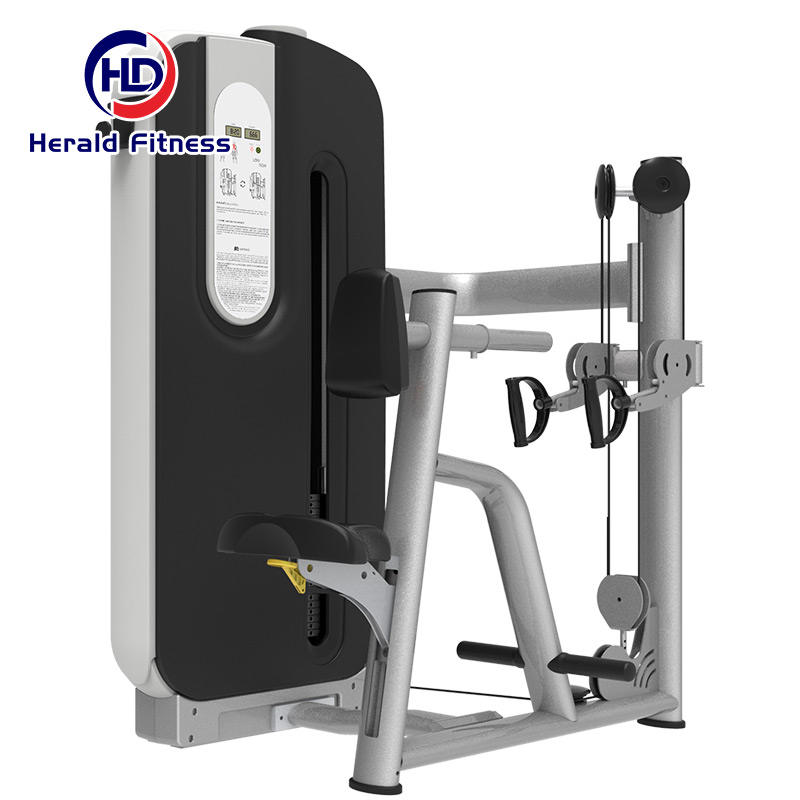A two-way low row machine, also known simply as a low row machine, is a specialized piece of fitness equipment designed primarily to target the muscles of the upper back, including the latissimus dorsi, rhomboids, and trapezius muscles. Here’s a detailed description of a typical two-way low row machine:
- Design and Construction:
- Frame: Constructed from heavy-duty steel or alloy to provide stability and durability.
- Seat and Chest Support: Features an adjustable seat and chest support (pads or cushions) to accommodate users of different heights and body sizes, ensuring proper alignment and comfort during exercises.
- Handles: Equipped with ergonomic handles or grips attached to a cable or lever system that allows for pulling movements.
- Footplates or Footrests: Includes non-slip footplates or footrests to stabilize the lower body during exercises.
- Exercise Motion:
- Targeted Muscles: Focuses on the muscles of the upper back, particularly the latissimus dorsi (lats), rhomboids, and trapezius muscles.
- Movement Pattern: Involves a pulling motion where the user pulls a handle or grip towards the body against resistance. This movement typically mimics a rowing motion.
- Variations: Some machines allow for different grip positions (e.g., wide grip, narrow grip, neutral grip) to vary the emphasis on different areas of the back and arms.
- Resistance System:
- Weight Stack or Plate-Loaded: Offers resistance through a weight stack (stack of rectangular weight plates with a selector pin) or plate-loaded system (where users load standard or Olympic weight plates onto a peg).
- Adjustability: Users can adjust the resistance by selecting different weight increments using a pin or by adding/removing weight plates, allowing for progressive overload.
- Safety and Comfort Features:
- Stability: Non-slip footplates or footrests provide stability and support during exercises.
- Range of Motion Control: Some machines include a range limiter or stopper to set the maximum range of motion, preventing overextension or injury.
- Handles: Ergonomically designed handles or grips with padding or textured surfaces to ensure a secure and comfortable grip during exercises.
- Benefits:
- Muscle Targeting: Targets and strengthens the muscles of the upper back, improving posture, stability, and muscular endurance.
- Compound Movement: Engages multiple muscles simultaneously, including the biceps, forearms, and shoulders, depending on the grip and technique used.
- Functional Strength: Enhances performance in activities requiring pulling and lifting movements, such as sports, manual labor, and everyday tasks.
- Rehabilitation: Used in physical therapy and rehabilitation programs to rehabilitate and strengthen the back muscles after injuries or surgeries.
- Usage and Applications:
- Strength Training: Essential for individuals looking to develop strength and definition in the upper back and improve overall back health.
- Fitness Programs: Suitable for users of varying fitness levels, from beginners to advanced lifters, due to its adjustable resistance and ergonomic design.
- Athletic Performance: Beneficial for athletes seeking to improve performance in sports that require upper body strength and pulling power, such as rowing, swimming, and climbing.
- Maintenance:
- Cleaning: Wipe down the machine after each use to remove sweat and prevent corrosion.
- Inspect Components: Regularly check cables, pulleys, and weight stacks for wear and tear, ensuring smooth operation and user safety.
- Lubrication: Apply lubricant to moving parts as recommended by the manufacturer to maintain optimal performance and extend the machine’s lifespan.
In summary, a two-way low row machine is a versatile and effective piece of strength training equipment designed to target and strengthen the muscles of the upper back through controlled pulling movements. It provides adjustable settings, safety features, and ergonomic design to deliver effective workouts for users aiming to enhance back strength, stability, and muscular development.



















































Reviews
There are no reviews yet.